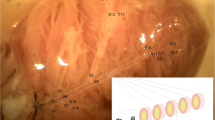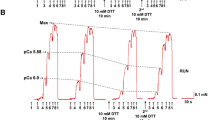Summary
Twenty young female Sprague-Dawley rats were randomly assigned to 2 groups. Ten animals served as sedentary controls, the 10 experimental animals were subjected to a training program with gradually increasing intensity of 18 weeks duration on a motor-driven treadmill. The rats were fixed by retrograde vascular perfusion via the abdominal aorta under anesthesia. Two transverse and 2 longitudinal sections per animal were selected at random from the left ventricular papillary muscles for light and electron microscopic stereological investigation. Length density and surface density of myocardial cells and capillaries were estimated with correction for partial anisotropy and curvature by means of the mathematical model of a Dimroth Watson orientation distribution. Left and right ventricular weight increased by 20% in the exercise group (P<0.001), whereas body weight remained unchanged. Physical training led to a significant increase of heart muscle fiber cross-sectional area by 17% (P<0.01). The ultrastructural volumetric composition of the myocardial cell cytoplasm by myofibrils, mitochondria, and sarcoplasmic matrix remained unchanged. Volume density, length density and surface density of capillaries, as well as capillary cross-sectional area and capillary anisotropy parameters were not significantly altered by training. From the data one concludes an increase of the 3-dimensional capillary-fiber ratio by 19% (P<0.001). Thus physical training induces mild absolute biventricular cardiac hypertrophy in young female rats, in which capillary proliferation compensates for the increase of mean oxygen diffusion distance resulting from fiber thickening, by supplying each unit of fiber length by more units of capillary length.
Similar content being viewed by others
References
Anversa P, Olivetti G, Melissari M, Loud AV (1980) Stereological measurement of cellular and subcellular hypertrophy and hyperplasia in the papillary muscle of adult rat. J Mol Cell Cardiol 12:781–795
Anversa P, Beghi C, Levicky V, McDonald SL, Kikkawa Y (1982) Mophometry of right ventricular hypertrophy induced by strenuous exercise in rat. Am J Physiol 243:H856-H861
Anversa P, Levicky V, Beghi C, McDonald SL, Kikkawa Y (1983) Morphometry of exercise-induced right ventricular hypertrophy in the rat. Circ Res 52:57–64
Anversa P, Beghi C, Levicky V, McDonald SL, Kikkawa Y, Olivetti G (1985) Effects of strenuous exercise on the quantitative morphology of left ventricular myocardium in the rat. J Mol Cell Cardiol 17:587–595
Astorri E, Bolognesi R, Colla B, Chizzola A, Visioli O (1977) Left ventricular hypertrophy: a cytometric study on 42 human hearts. J Mol Cell Cardiol 9:763–775
Bell RD, Rasmussen RL (1974) Exercise and the myocardial capillary-fiber ratio during growth. Growth 38:237–244
Bloor CM, Leon AS (1970) Interaction of age and exercise on the heart and its blood supply. Lab Invest 22:160–165
Bozner A, Meessen H (1969) Die Feinstruktur des Herzmuskels der Ratte nach einmaligem und nach wiederholtem Schwimmtraining. Virchows Arch B [Cell Pathol] 3:248–269
Breisch EA, White FC, Bloor CM (1984) Myocardial characteristics of pressure overload hypertrophy. A structural and functional study. Lab Invest 51:333–342
Claycomb WC (1975) Biochemical aspects of cardiac muscle differentiation. J Biol Chem 250:3229–3235
Crisman RP, Rittman B, Tomanek RJ (1985) Exercise-induced myocardial capillary growth in the spontaneously hypertensive rat. Microvasc Res 30:185–194
Crisman RP, Tomanek RJ (1985) Exercise training modifies myocardial mitochondria and myofibril growth in spontaneously hypertensive rats. Am J Physiol 248:H8-H14
Cruz-Orive LM, Hoppeler H, Mathieu O, Weibel ER (1985) Stereological analysis of anisotropic structures using directional statistics. Appl Statist 34:14–32
Doerr W (1971) Morphologie der Myokarditis. Verb Dtsch Ges Inn Med 77:301–335
Doerr W, Rossner JA (1977) Toxische Arzneiwirkungen am Herzmuskel. Springer, Berlin Heidelberg New York (Sitzungsberichte der Heidelberger Akademie der Wissenschaften 77/4:175–207
Friedman I, Moravec J, Reichart E, Hatt PY (1973) Subacute myocardial hypoxia in the rat. An electron microscopic study of the left ventricular myocardium. J Mol Cell Cardiol 5:125–132
Gundersen HJG (1977) Notes on the estimation of the numerical density of arbitrary profiles: the edge effect. J Microsc 111:219–223
Holtz J, von Restorff W, Bard P, Bassenge E (1977) Transmural distribution of myocardial blood flow and of coronary reserve in canine left ventricular hypertrophy. Basic Res Cardiol 72:286–292
Hort W (1951) Morphologische und physiologische Untersuchungen an Ratten während eines Lauftrainings und nach dem Training. Virchows Arch 320:197–237
Hort W, Frenzel H, Lange P, Tezuka F (1985) Rückbildung der Herzhypertrophie.In: Mall G, Otto HF (eds) Herzhypertrophie, Springer, Berlin pp 43–47
Hudlicka O (1982) Growth of capillaries in skeletal and cardiac muscle. Circ Res 50:451–461
Koyanagi S, Eastham CL, Harrison DG, Marcus ML (1982) Increased size of myocardial infarction in dogs with chronic hypertension and left ventricular hypertrophy. Circ Res 50:55–62
Laughlin MH, Diana JN, Tipton CM (1978) Effects of exercise training on coronary reactive hyperemia and blood flow in the dog. J Appl Physiol 45:604–610
Leon AS, Bloor CM (1968) Effects of exercise and its cessation on the heart and its blood supply. J Appl Physiol 24:485–490
Lin H-L, Katele KV, Grimm AF (1977) Functional morphology of the pressure- and the volume-hypertrophied rat heart. Circ Res 41:830–836
Linzbach AJ (1947) Mikrometrische und histologische Analyse hypertropher menschlicher Herzen. Virchows Arch [Pathol Anat] 314:534–594
Linzbach AJ (1960) Heart failure from the point of view of quantitative anatomy. Am J Cardiol 5:370–382
Ljungqvist A, Unge G (1977) Capillary proliferative activity in myocardium and skeletal muscle of exercised rats. J Appl Physiol 43:306–307
Loud AV, Beghi C, Olivetti G, Anversa P (1984) Morphometry of right and left ventricular myocardium after strenuous exercise in preconditioned rats. Lab Invest 51:104–111
Mall G, Reinhard H, Kayser K, Rossner JA (1978) An effective morphometric method for electron microscopic studies on papillary muscles. Virchows Arch [Pathol Anat] 379:219–228
Mall G, Mattfeldt T, Volk B (1980) Ultrastructural morphometric study on the rat heart after chronic ethanol feeding. Virchows Arch [Pathol Anat] 389:59–77
Mall G, Mattfeldt T, Rieger P, Volk B, Frolov VA (1982) Morphometric analysis of the rabbit myocardium after chronic ethanol feeding - early capillary changes. Basic Res Cardiol 77:57–67
Mathieu O, Cruz-Orive LM, Hoppeler H, Weibel ER (1983) Estimating length density and quantifying anisotropy in skeletal muscle capillaries. J Microsc 131:131–146
Mattfeldt T, Mall G, Volk B (1980) Morphometric analysis of rat heart mitochondria after chronic ethanol treatment. J Mol Cell Cardiol 12:1311–1319
Mattfeldt T, Mall G (1983) Dipyridamole-induced capillary endothelial cell proliferation in the rat heart - a morphometric investigation. Cardiovasc Res 17:229–237
Mattfeldt T, Mall G (1984) Estimation of length and surface of anisotropic capillaries. J Microsc 135:181–190
Mattfeldt T, Möbius H-J, Mall G (1985) Orthogonal triplet probes: an efficient method for unbiased estimation of length and surface of objects with unknown orientation in space. J Microsc 139:279–289
McElroy CL, Gissen SA, Fishbein MC (1978) Exercise-induced reduction in myocardial infarct size after coronary artery occlusion in the rat. Circulation 57:958–962
Merz WA (1967) Die Streckenmessung an gerichteten Strukturen im Mikroskop und ihre Anwendung zur Bestimmung von Oberflächen-Volumen-Relationen im Knochengewebe. Mikroskopie 22:132–142
Mueller TM, Marcus ML, Kerber RE, Young JA, Barnes RW, Abboud FM (1978) Effect of renal hypertension and left ventricular hypertrophy on the coronary circulation in dogs. Circ Res 42:543–549
O'Keefe DD, Hoffman JIE, Cheitlin R, O'Neill MJ, Allard JR, Shapkin E (1978) Coronary blood flow in experimental canine left ventricular hypertrophy. Circ Res 43:43–51
Oscai LB, Molé PA, Holloszy JO (1971) Effects of exercise on cardiac weight and mitochondria in male and female rats. Am J Physiol 220:1944–1948
Pannier JL, Leusen I (1977) Regional blood flow in response to exercise in conscious dogs. Eur J Appl Physiol 36:255–265
Schaible TF, Scheuer J (1981) Cardiac function in hypertrophied hearts from chronically exercised female rats. J Appl Physiol 50:1140–1145
Scheuer J (1982) Effects of physical training on myocardial vascularity and perfusion. Circulation 66:491–495
Scheuer J, Tipton CM (1977) Cardiovascular adaptations to physical training. Ann Rev Physiol 39:221–251
Spear KL, Koerner JE, Terjung RL (1978) Coronary blood flow in physically trained rats. Cardiovasc Res 12:135–143
Tomanek RJ (1970) Effects of age and exercise on the extent of the myocardial capillary bed. Anat Rec 167:55–62
Tornling G, Unge G, Skoog L, Ljungqvist A, Carlsson S, Adolfsson J (1978) Proliferative activity of myocardial capillary wall cells in dipyridamole-treated rats. Cardiovasc Res 12:692–695
Tornling G (1982) Capillary neoformation in the heart and skeletal muscle during dipyridamole-treatment and exercise. Acta Pathol Microbiol Scand A (Suppl) 278:1–63
Van Liere EJ, Krames BB, Northup DW (1965) Differences in cardiac hypertrophy in exercise and in hypoxia. Circ Res 16:244–248
Weibel ER (1980) Stereological Methods. II. Theoretical Foundations. London, Academic Press
Wright AJA, Hudlicka O (1981) Capillary growth and changes in heart performance induced by chronic bradycardial pacing. Circ Res 49:469–478
Author information
Authors and Affiliations
Rights and permissions
About this article
Cite this article
Mattfeldt, T., Krämer, KL., Zeitz, R. et al. Stereology of myocardial hypertrophy induced by physical exercise. Vichows Archiv A Pathol Anat 409, 473–484 (1986). https://doi.org/10.1007/BF00705418
Accepted:
Issue Date:
DOI: https://doi.org/10.1007/BF00705418




